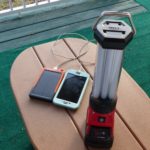by Winding Pathways | Apr 11, 2024 | (Sub)Urban Homesteading, Home Improvements
A rarely used handy tool made our lives easier after we found a box on our porch. It contained a remote weather station our two grown children chipped in to buy it for us.
Many parts needed to be assembled. That would have been difficult had we not been “tool proactive”. The weather station had a small door that covered a battery compartment. Opening it required using a tiny mini screwdriver.
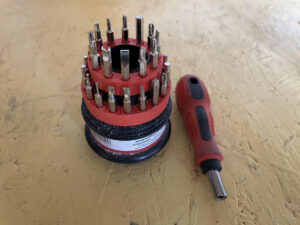
Screwdriver set with mini-bit-heads.
Rich occasionally buys somewhat unusual tools to help with special household or yard needs. One was a lifesaver for putting together the weather station. It was a mini screwdriver kit with about 20-bit heads made for jobs too small for normal tools. It helped us easily and quickly assemble the weather station.
How We Organize Tools at Winding Pathways
House Tools. Easy to Grab
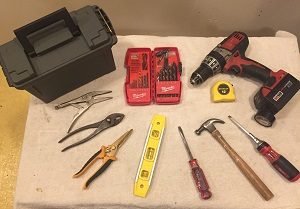
We find Milwaukee Tools, Stanley, and Vice Grips three excellent brands to have around.
We keep a toolbox in the house for quick needs. It includes Phillips and slot screwdrivers, pliers, Marion’s mother’s mini hammer, an adjustable wrench, measuring tape, a small “torpedo” level, a scraper, and a short coil of wire. The house toolbox is close at hand and enables us to fix most problems inside the house.
More Serious Diverse Tools.
Rich keeps major project tools on a pegboard in our cabin. These include hammers, squares, hand saws, many types of screwdrivers and pliers, files, chisels, hearing protectors, and clamps. On a nearby shelf is a toolbox holding rarely used tools. They’re specialty ones used when encountering unusual fixit or carpentry needs. These include odd drill bit sizes, unusually shaped files, contour gauges, and even a set of carving tools. Although not often used, once in a while they make life easy when a project has an odd need.
Battery Powered Power Tools
Although muscle-powered tools are perfect for small jobs, power tools make many projects shorter and easier. Rich keeps a drill, driver, jigsaw, circular saw, and sanders in a cabin cabinet. Over several years, battery-powered, or cordless, tools have come on the market. They are gradually replacing corded counterparts. Several companies make them, and each has its own battery system. It’s best to stay with one brand, so all tools operate on the same style battery. Rich began building his tool system with the Milwaukee brand years ago and occasionally buys a new power tool to add to the system. His Milwaukee batteries power carpentry tools as well as trimmers and chainsaws for outside use.
-
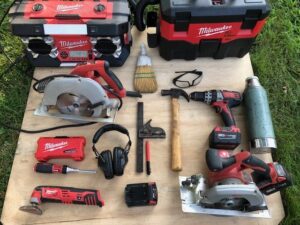
-
We switched to cordless tools gradually.
-
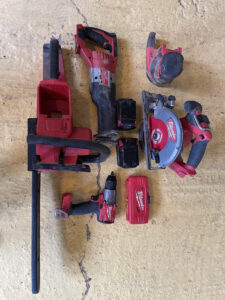
-
Stick with one brand of tools.
Tool Tips
- Buy quality tools. There’s a lot of junk on the market. Quality tools of any configuration are easier to use and last longer than cheap ones.
- Frequent garage sales. Years ago, most screwdrivers, wrenches, pliers, chisels, and clamps were high quality and made in the United States. These muscle-powered tools don’t go obsolete and often can be purchased for just a buck or two, even if they’re 40 or 50 years old. In contrast, many power tools sold at garage sales are equally old and inexpensive but often are much less effective than newer counterparts. Most are corded. They may be fine for occasional jobs but buying newer power tools is usually worth the money.
-
-
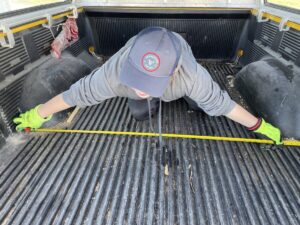
-
One way to measure a truck bed.
-

-
Learning to safely use tools.
Summary
Fixing and building items around the house can be a chore or a source of satisfying pride. Often, it’s impossible to find someone to hire for small fixit jobs, and hiring anyone to do a project is costly. Doing it yourself brings cost savings and satisfaction. Don’t know how? Check your friend, YouTube. Chances are good there are many posts showing how to fix or build it.
by Winding Pathways | Feb 29, 2024 | (Sub)Urban Homesteading, Home Improvements, Nature, Trees
Knot Just Lumber
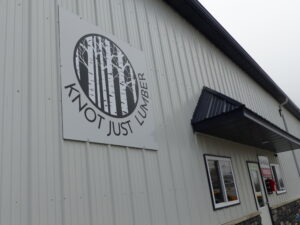
A local store
When driving through Hiawatha, Iowa, recently, a nondescript sign caught our eye. Posted on what looked like a warehouse the sign said, KNOT JUST LUMBER. We had to check it out and soon entered the ultimate wood candy store.
Leaning upright were immense slabs of white and red oak, walnut, cherry, and mulberry destined to become gorgeous tables. Nearby were smaller boards of at least a dozen tree species. Most were cut from native Iowa trees, but some racks held exotic wood from foreign lands. Purpleheart caught our eyes. It comes from trees that grow in Central and South America. When first cut the wood is dull grayish but within a few days, it transforms into an eggplant purple color.
Local Connections
We returned to visit Nic Carter, who co-owns the store with his sister, Caris. The family is from Alburnett and Nic was an active 4-H member dabbling in woods making jewelry boxes for art shows. After stints as a woodworker and home builder Nic, and his family opened Knot Just Lumber in September 2022. He and his sister decided to open the store because, “The area has no local woodworking place, so, I started one here,” he explained.
His father and son help run this family-owned and operated business located just north of Cedar Rapids. We enjoyed an in-person tour, which is augmented by their website and includes a virtual walk-through.
Knot Just Lumber caters to hobbyists, commercial customers, and families. We have visited several times and enjoyed chatting with individual customers and couples, and watched kids touch and smell the smooth, fragrant wood. The company buys trees from wood brokers. Most originate from trees in southern Iowa. The company mills wood into various-sized boards and turning rounds, dries it in an onsite kiln, surface planes, and sands most boards.
Wood is Special
Wood is special. We’ve noticed that in many brand-new houses doors, window frames, and floors are crafted from composite materials and plastic.
Nothing seems natural. In contrast, our 1947-era house has floors of Douglas Fir and White Oak with our furniture crafted from solid oak, pine, walnut, and cedar. Different woods make our home feel closer to nature while gracing us with the individual vibrant colors, textures, and grain patterns of each species. The woods connect us to woodworkers, friends, and craftspeople from bygone and current eras.
Commercial Lumber
Commercial lumber is usually cut from the straightest and most uniform trees. Buy it from a large commercial outlet and it’s attractive and easy to work but lacks the character implanted in wood by knots and irregular growth. In contrast, every wood slab we saw at Knot Just Lumber showed the individuality and character of the tree that created it. “Some of the most interesting wood comes from trees that grew in urban areas where their branches spread widely. It helps give the wood wonderful character and beautiful grain,” said Nic.
Unfortunately, every year millions of trees, many growing in towns, are felled after they die. Beautiful wood inside the bark is frequently hauled to a landfill, ground into shavings, or cut for firewood. Knot Just Lumber converts old veteran trees into lumber destined to be crafted into furniture that endures for generations. The company even saves sawdust and compresses it into briquettes to feed a wood stove or campfire. We bought some and found that they work wonderfully. We appreciated Nic’s caution that they do burn hot, so we use them sparingly. We are excited to use them with our occasional campfires out back.
-

-
Value added and no waste.
-

-
Fungi-laced wood
A Way to Add Character to a Room
The materials from our recent downstairs bathroom renovation are mostly manmade. That’s understandable, as the surfaces need to be easily cleaned and resist moisture. But the room needed the character of wood. So, we bought an oak board from Knot Just Lumber to cover a small area of plaster. It adds the warmth of nature to an otherwise utilitarian space.
Hidden Gems

Fusing old and new technology.
Knot Just Lumber is a local store we found by accident. The staff consult, have working spaces and classes for customers and specialize in epoxy with the wood to create gorgeous pieces for homes. Their prices are reasonable, especially compared to national stores or online sources. Similar local stores are scattered across the country. Finding them can be tricky but hobbyist woodworkers know where they are and anyone can Google hardwood lumber and they might learn of a nearby place to buy gorgeous local wood.
Resources
One of our favorite resources to learn the diverse characteristics of dozens of different species of native and exotic woods is the book WOOD! Identifying and Using Hundreds of Woods Worldwide, by Eric Meier.
-
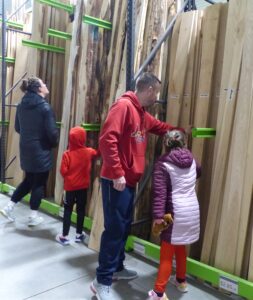
-
Families taking in the lumber.
-

-
Assessing lumber.
-

-
wood has a characteristic smell.
by Marion Patterson | Mar 23, 2023 | (Sub)Urban Homesteading, Energy Efficiency, Home Improvements
Are battery-powered chainsaws worth the money?
We decided to find out. *
Gas chainsaws have been around for decades. Rich wondered if newer electric battery-powered chainsaws would be as functional and easier to use. So, he acquired a Milwaukee saw with a 16-inch bar and put it to the test alongside his trusty Stihl gas model.
Back in the mid-1970s Rich worked in Idaho felling Douglas Fir and Ponderosa Pine trees. He used a heavy noisy gas fueled chainsaw that was amazingly powerful as it chewed through thick trunks. Years later he bought a Stihl gas-powered saw used to cut the four or five cords of wood we burn each winter for heat. It’s a well-built powerful saw.
A few days after the new battery saw arrived, we heard a crack/boom as a huge oak crashed down across one of our backyard trails. Rich guided the new saw as it sliced through the log, and emerged smiling. “It’s amazing,” he said.
After further use he developed this chart of the pros and cons of the battery vs the gas saw:
Gas: Pro – Plenty of Power, No need to recharge batteries, Longer bar
Gas: Con Noisy and heavy, Must mix/carry/store gas, Must replace gas & air filters, Engine stalls, Pull cord start hard on the shoulder.
Battery: Pro – Plenty of Power, Relatively quiet, Less maintenance, Fairly lightweight, Trigger start, No need to idle, Easy start
Battery: Con – Need a nearby electric outlet to recharge the battery, Shorter bar than a gas saw
Bottom Line. Which One to Buy
Rich has both a gas and electric battery saw. Both are well-made by reliable companies. So, if he didn’t own a saw and needed to cut up trees fallen in the yard which type would he buy?
“I’d buy a quality battery saw. They are easy to use, cut fast, and there’s no need to buy, mix, and store gas. They are also quiet, but I still use hearing protection when using one. There are major advantages of battery over gas. One is
eliminating the need to pull a cord to start it. You just pull the trigger. The second is especially helpful when cutting a fallen tree with branches. Often this requires cutting, then putting the saw aside to clear away the cut branches, then using the saw to cut more. Gas saws don’t idle well and often stall, requiring another pull on the starter cord. Also, when idling gas saws burn fuel and spew emissions. Battery saws excel when there’s a need to cut and then move wood.”
Battery-powered chainsaws use lots of electricity. He was able to cut 13 15-inch diameter black oak logs on one charge with a 12-amp hour battery. The saw will function well on batteries with lower amp hour ratings, but they will run down sooner. He suggests having two 12-amp hour batteries and notes that being close to a power source for recharging is useful. It is likely that the cost of recharging a battery is lower than the comparable amount of energy in gasoline but it’s difficult to make a comparison.
Safety
Operating any chainsaw must be done with safety in mind. Here is Rich’s list of safety precautions to keep in mind:
- Get saw training. In-person training is best but YouTube videos help.
- Always wear protective equipment that includes saw chaps, leather gloves, hearing, ear, head and eye protection, and sturdy leather boots.
- Saw with a partner nearby and carry a cell phone in case of emergency.
- Keep the chain sharp. YouTube videos show how to sharpen.
- Rest before you get tired.
- Be alert. Save the cold beer for after you are done.
-
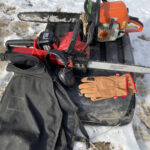
-
Gas and battery saws with protective equipment.
-
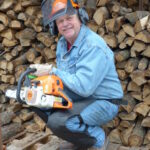
-
Rich in protective equipment.
-

-
Quality gas and electric saws.
Final Thoughts
Rich has years of experience using many power tools and shares these thoughts:
Quality pays. “I buy quality tools, even if I have to wait until I save up enough money. Most of my tools are Milwaukee brand. The same batteries that power my chainsaw also power my drills, fans, vacuum cleaner, lights, inflater, hedge trimmer and other saw types. Many quality brands are on the market. They have their own specific type of battery that won’t work with other brands. So, I consistently buy the same brand for convenience.
Yard Tool’s Future
At Winding Pathways, we have replaced our gas lawn mower, snowblower, and now chainsaw with battery-powered equivalents. They are excellent and come with benefits over gas models. We see gas yard tools moving toward obsolescence and battery-powered ones becoming ever more versatile.
Disclosure*
Rich has purchased, at retail cost, most of his power tools. Milwaukee has provided others for testing.
by Winding Pathways | Jan 19, 2023 | (Sub)Urban Homesteading, Energy Efficiency, Home Improvements, Preparedness
Power outages. They happen in an instant. Most are only a flicker but some can last for hours when the wind’s whistling and the temperature’s dropping outside. Or in summer when the heat rises.
What’s the best thing to do in power outages? Well, it’s best to anticipate it and be ready by having a few things ready to pull out of the closet when the lights go out. Here’s a short list:
Cooking and Food:
- Propane or gas camping stove with plenty of fuel stored away from the main residence. (i.e. in a stand-alone garage) If you live in an apartment or condominium have less volatile fuel options ready.
- A few days of nonperishable or dehydrated camping food.
- Several gallons of water stored where it won’t freeze.
Power Outages and Light & Heat:
Electronics:
- Cell phones and other electronic batteries drain quickly. A backup power source and solar-powered phone charger keep the phone working.
One More Important Item:
- In a widespread power failure credit and debit cards don’t work. Cash always does. Keep some cash in small bills to use during emergencies.
Many other items readily available in case of emergencies help keep life comfortable. Read about them on our other blogs. The list above covers only the most basic and sometimes overlooked, emergency items to keep on hand. Get ready now for power outages.
-

-
We found the meals tasty and filling.
-
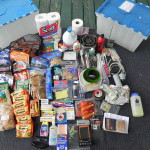
-
emergency food
-
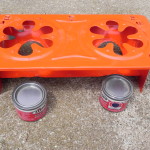
-
This two-burner Sterno keeps food warm but is less useful for cooking. Great for old style fondue parties!
by Winding Pathways | Jun 23, 2022 | (Sub)Urban Homesteading, Energy Efficiency, Home Improvements
Want to buy gas for a buck a gallon? Well, you can but you won’t find it at a service station. It’s available at the electrical outlet in the garage or shop.
Battery-Operated Tools
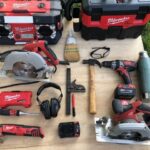
We switched to cordless tools gradually.
Nearly ten years ago we switched from plug-in carpentry tools to battery (cordless) equivalents. We loved them for their power, effectiveness, quietness, and ease of use. So, when battery-powered yard tools came on the market we gradually switched.
In 2018 we ditched our gas lawn mower and replaced it with a battery unit….with concern. Would it have the power of our gas machine to chew through tall grass and weeds? Would it have enough battery storage to mow the entire lawn?
Mowers
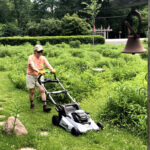
Maintaining the labyrinth is work. And a way to connect.
We quickly learned our concerns were false. The mower chewed through tough prairie grass and buzzed off our traditional lawn with ease. We liked it so much we bought another one so we could both mow simultaneously. Then came a trimmer, chain saw, and snow blower that all run on the same battery system. We love them all and believe gas-powered equivalents are on the road to obsolescence.
How about operating costs? Experts at our utility, Alliant Energy, told us that one gallon of gasoline has the energy equivalent of 33.7-kilowatt hours of electricity. As of mid-June 2022, gasoline average cost pushed to $4.60+ a gallon in Cedar Rapids. 33.7 kWh of electricity costs, on average in Iowa, $1.03.
Operating our battery tools costs a quarter of our old gas equivalents.
Benefits of Electric Tools

Comparison of a gas mower and the EGO cordless lawnmower.
But, there’s more than cost savings with battery-operated tools. Here are aspects we love about our mowers, trimmers, saws, and snowblowers:
- No rope to pull to start the machine. We save the shoulders! Just press a switch.
- No filters or oil to change.
- No need to buy and store gasoline. Fuel is always at hand at the electrical outlet.
- No fumes to breathe while operating.
- No noisy internal gas explosions. Battery electric machines are quiet.
- Easy to fold and store.
So, what are the downsides of battery-operated tools? We had to think about that and came up with only one thing. They may cost more than gas machines, and batteries are expensive. However, the batteries last a long time, perhaps as many as 2000 charge/discharge cycles.
The cost of electricity varies from place to place. Utilities print the kilowatt-hour charge on monthly bills. To calculate the cost of 33.7 kWh of electricity multiply that number by your per kWh cost and add in any taxes or service fees. Almost certainly it will cost less to charge a battery than to buy gas.
Have a cranky old gas mower? We suggest replacing it with a battery-powered equivalent.
by Winding Pathways | Nov 28, 2019 | (Sub)Urban Homesteading, Home Improvements
Winding Pathways appreciates and enjoys quality tools. So, we have an affiliate relationship with Acme Tools. We do this because of their quality tools, supplies, and outstanding customer service.
Acme Tools carries multiple brands. All are of high quality. They are reliable, safe, and user-friendly. People come in different sizes. Customers can find different sized tools comfortable for anyone of any size to use.
After years of using bargain tools that frequently broke or failed, Winding Pathways went to Acme Tools and purchased various Milwaukee Brand tools. They cost a little more upfront. In the long run, this purchasing philosophy has saved us money and reduced frustration.
Quality tools sold by Acme Tools last a long time and, unlike cheaper counterparts, can be repaired.
Here are some Milwaukee items we have purchased at Acme Tools and enjoy using.
Cordless Drills
Cordless Multi-Tool
Cordless Saws
Flashlights
Apparel – Jackets, Gloves, and more
Radio
Hand Tools – Screwdrivers, hammers, measurers, squares, and more
Vacuum Cleaners

















